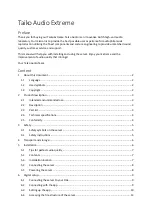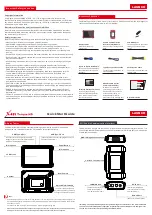
ULTRATHERM 908i
12
gbo Medizintechnik AG 2004
Version 1.2
3.1.4. Output circuit - subassembly A300
The output circuit is provided to match the application part, which is connected to the balanced
output X004/X005, as exactly as possible to the generator. The matching is performed by means of
the adjustable capacitor C302 driven by stepping motor M301, which is a component of a serial
circuit in connection with the coils L302 and L303. The RF power is fed through connection
X301. The RF power flows via the capacitor chain C303 to C305 to the balance-to-unbalance
transformer L301/L302/L303 whose secondary windings are parts of the serial circuit mentioned
above.
The stepping motor is triggered by control computer A400. 4 additional diodes protect the
stepping motor (they are not drawn in the wiring diagramm).
All other parts, given in the layout, are not required.
3.1.5. Control computer - subassembly A400
Subassembly A400 is the central unit which realizes all signal and operation functions as well as
measurement and control operations. The micro-controller 87C196KB, which reduces the
computer hardware to a minimum and, thus, is a very service-friendly solution, is the basis of this
control computer.
The integrated circuit 87C196KB contains clock generator, CPU, program memory, A/D
converter, counter/timer and several different input and output ports. For clock generation (8 Mhz)
only the external components Q401, C406 and C406 are to be connected. After switchingon the
watch-dog circuit D401 generates a reset signal and initiates a defined start of the internal
program. But the generation of the reset signal is also possible by means of key S409. The supply
vo5 V, +15 V and -15 V are applied to the subassembly via X403. Mode of operation,
applicator type and treatment time are adjusted by means of the key matrix S401 to S408 and S410
to S412. They are triggered by the output ports P1.4 to P1.7 and evaluated by the input ports P2.1
to P2.3 which are loaded by the pull-up resistors R449 to R451. The output power is adjusted by
means of pulse generator D408, feeding the two direction-of-rotation dependent signals (2) and (4)
to the prosessor via NMI and P0.5. Processor output P2.5/PWM delivers a pulse-duration
modulated signal that is converted to a DC voltage by the two operational amplifier networks
N401A/N401B and used to control the power output of generator A200. The connection C402 to
D402 (P0.6) is used to monitor the D/A conversion. In the pulsed modes of operation the DC
voltage is keyed via processor output pin P4.7/AD15 and transistor T401. The generator control
voltage, the level of which is also monitored by processor (P0.6), applies at plug connector
X401.5. The bar indicator VD401 consists of ten LEDs and signals the degree of matching
between patient circuit and generator output. The individual LEDs VD402 to VD410 have the
following meaning:
VD402
signals the adjustment of the „
DIPLODE
“ applicator.
VD403
signals the adjustment of the Medium coil-field „
MONODE
“ applicator.
VD404
signals the adjustment of the Small coil-field „
MINODE
“ applicator.













































